The configuration of layover areas should consider:
Bus vehicle tracking should be undertaken during the design of layover sites to identify any potential conflicts between manoeuvring buses. It is recommended that the design of off-street layovers keep buses separate from general traffic, pedestrians and cyclists to avoid safety issues with manoeuvring buses.
For further information about vehicle dimensions, refer to:
Bus dimensions and tracking
Parallel parking is the most common type of bus layovers, with buses parked parallel to the carriageway. Parallel parking is often used for on-street locations because it requires less road width than angled parking and avoids the need for buses to reverse out of the layover space.

Parallel parking bus layover configuration.
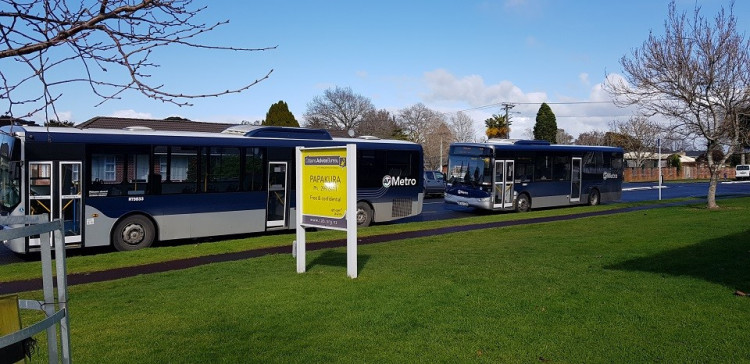
Example of on-street bus layover with parallel parking. (Source: Flow)
The amount of manoeuvring space provided between layover spaces can limit bus operations. This is because buses that are parked close together may result in insufficient space to allow each bus to independently enter or exit the layover space.
There are three types of operations at bus layovers and while these refer to parallel parking arrangements, the general principles may also apply to other layover configurations.
Independent operation provides enough manoeuvring space for buses to enter and exit a layover space without requiring the relocation of other buses. Independent operation allows bus drivers to leave their bus during scheduled layovers without preventing other buses from using the layover space. Providing enough space for independent operation is recommended for layover spaces which are used by multiple bus routes, different operators or long layovers.

Layover space with independent operation.
Semi-dependent operation means that a bus can exit the layover space but another bus cannot enter the layover space without relocating other buses. This is because buses require more manoeuvring space to pull into a parallel parking space than to pull out into an adjacent lane. Semi-dependent operation may be appropriate if bus drivers are scheduled to start their layovers at the same time, such as after a rail connection.

Layover space with semi-dependent operation.
Total dependent operation is where there is not enough manoeuvring space for a bus to enter or exit the layover facility without requiring the relocation of another bus. Total dependent operation is not preferred because it creates operational challenges and may result in poor service reliability from delays in leaving the layover space. Total dependent operation may encourage the driver of the last bus in the queue to attempt to reverse out of the layover space which can create safety issues.

Layover space with total dependent operation.
The recommended bus stop layout dimensions provided in the Bus stop guidance are also applicable for bus layovers.
One potential point of difference from a regular bus stop is the extent to which the layover needs to be able to accommodate independent bus operations.
The table below shows the minimum length that should be provided between layover spaces depending on the type of layover operation.
Minimum length between layover spaces based on layover operations:
|
Type of layover operation |
Minimum length between layover spaces (m=metres) |
Comment |
|
Independent operation |
15m |
A minimum of 15m is ideal for a bus to independently pull into or out of layover space. For constrained sites, an absolute minimum of 12m may be acceptable, subject to a swept path analysis. |
|
Semi-dependent operation |
9m |
A minimum of 9m is ideal for a bus to pull out of a layover space. For constrained sites, an absolute minimum of 5m may be acceptable, subject to a swept path analysis. |
|
Total dependent operation |
1.5m |
Recognises that buses do not park bumper to bumper and provides space for potential bike racks on front of buses* |
Angled parking is where the bus layover space is at an angled of 45° or 60° which is generally used for off-street layover sites. The advantage of angled parking is that this arrangement requires less length per layover space which may increase the number of layover spaces that can be accommodated within the site.
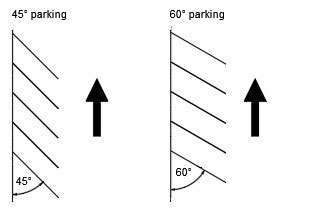
Angled parking bus layover configuration.
Angled parking can be arranged so that buses either reverse out or drive straight out through the layover space. For on-street layovers it is unsuitable to require bus drivers to reverse out of the space due to lack of visibility of other road users whilst reversing.
Examples of angled parking layovers for sites of different sizes and shapes:
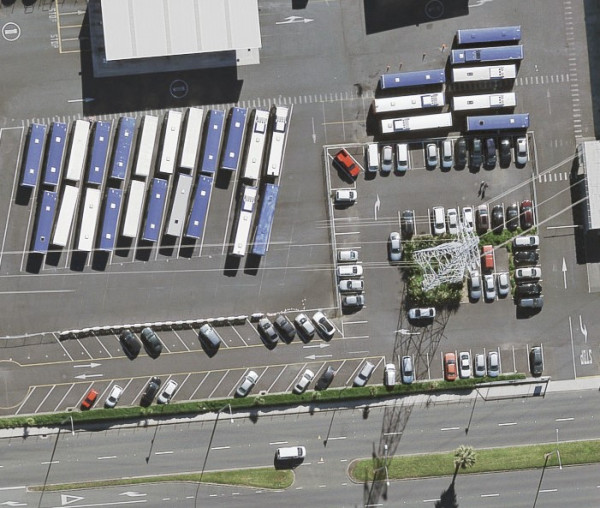
Off-street angled bus parking, Onehunga, Auckland (Source: LINZ, NZTA, Eagle Technology)
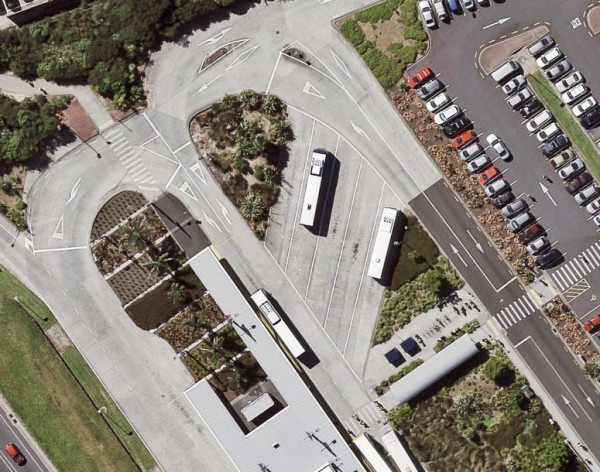
Off-street angled bus parking, Northern Busway, Auckland (Source: Auckland Council)

Off-street angled bus layover parking in Canberra, Australia (Source: ACT Government)
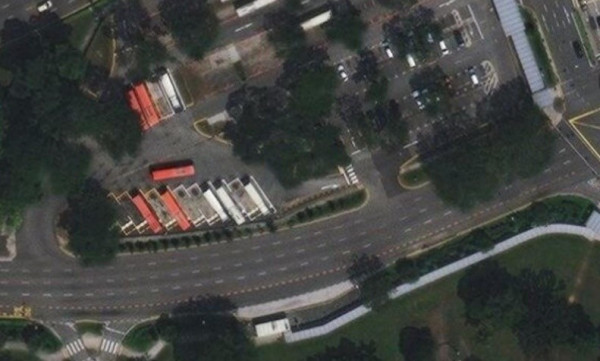
Off-street angled bus parking in Singapore (Source: Esri Community Maps Contributors, SLA, Esri, HERE, Garmin, METI/NASA, USGS)
Perpendicular bus layovers are when the bus is parked at a 90° angle. Perpendicular parking further reduces the width of the layover space required compared with angled parking but a larger area for manoeuvring is required.
It is recommended that perpendicular parking only be considered for off-street layover spaces (such as inter-city services) or bus depots. Perpendicular parking is not appropriate for on-street settings due to the safety issues from manoeuvring buses. Furthermore, perpendicular parking requiring reversing manoeuvres is not recommended for off-street layovers which have a high bus turnover due to the difficultly of manoeuvring in and out of the layover spaces.


Example of perpendicular bus layover parking (Source: LINZ, NZTA, Eagle Technology)
There are advantages and disadvantages of different layover configurations as outlined below:
|
Layover configuration |
Advantages |
Disadvantages |
|
Parallel parking |
|
|
|
Angled parking |
|
|
|
Perpendicular parking |
|
|
No single layover configuration is right or wrong, rather bus layover configurations need to be designed in a way to meet site-specific constraints and operational requirements.
Considerations include the size and shape of the sites, the capacity and duration of layovers and the way in which they access and egress the facility. An example is Otahuhu Bus Station in Auckland which has been designed to fit within a constrained site. It allows drivers to proceed in and out of the layover spaces in a forward gear while also allowing in service buses to pass around the outside of the layover area unhindered by layover movements.
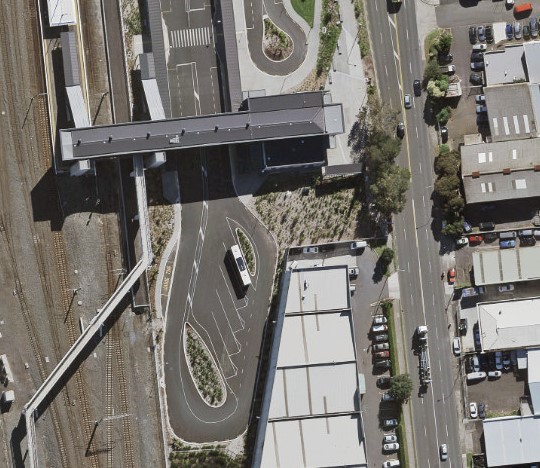
Example of constrained site at Otahuhu, Auckland (Source: LINZ, NZTA, Eagle Technology)
In more complex layover situations, for example where the size of layover spaces or the duration of the layover varies, it may be necessary to allocate layover spaces to driver shifts and their specific vehicle type. This can help to manage the available layover spaces more efficiently and reduce buses circling to find layover spaces.
Technology such as sensors at layover spaces should also be considered as a way to efficiently direct bus drivers to available layover spaces particularly when spaces are dispersed across a wider area.
For layovers serving articulated buses, reverse manoeuvres should be avoided in design. Refer to the articulated buses guidance note for additional guidance on design of the bus box and associated entry and exit tapers.